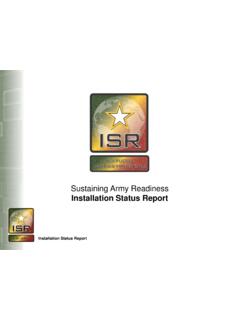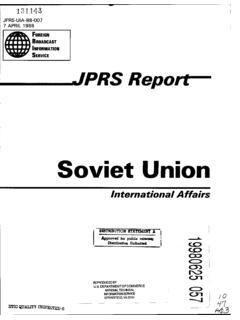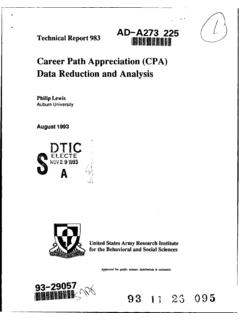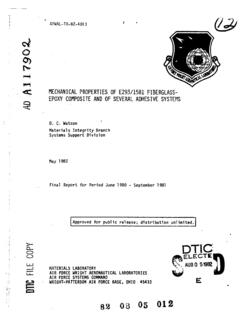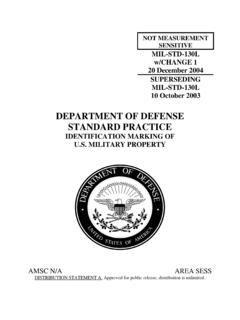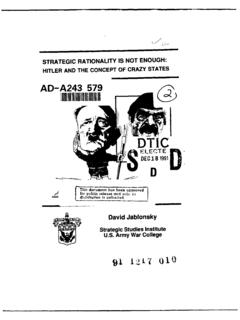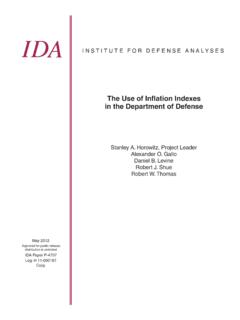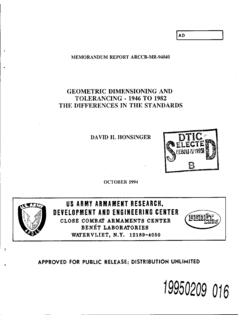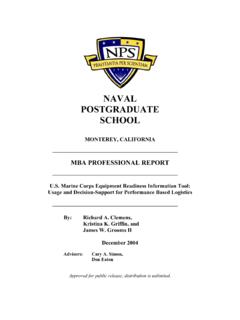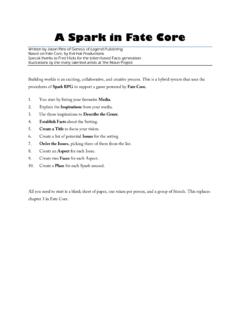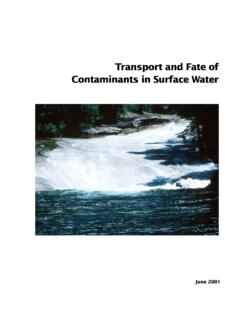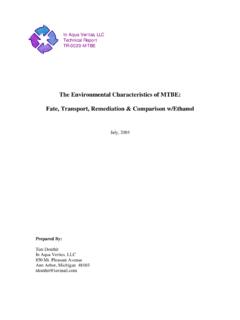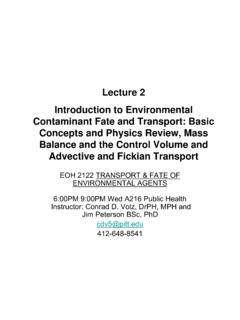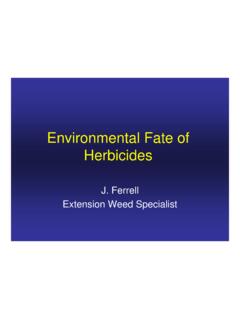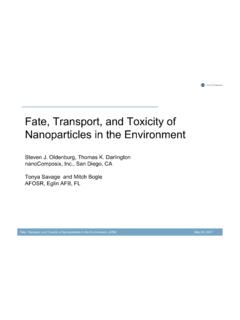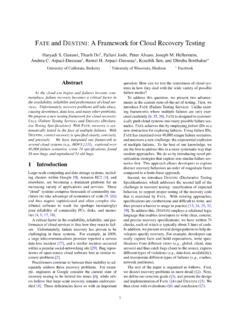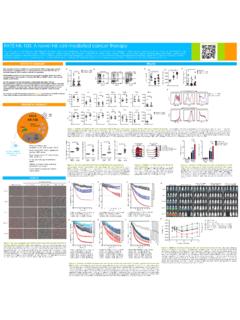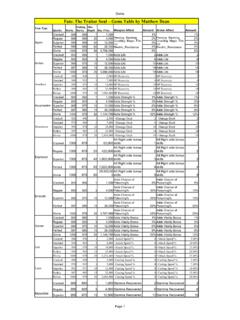Transcription of AUEQ-TR-1994-0026 THE FATE AND BEHAVIOR OF LEAD …
1 AUEQ-TR-1994-0026 THE FATE AND BEHAVIOR OF LEAD ALKYLS IN THE SUBSURFACE ENVIRONMENT A R M S T R O N G Dr. Mansell, Dr. L. Ou, Dr. Rhue Dr. Y. Ouyang Battelle Memorial Institute Environmental Technology 505 King Avenue Columbus OH 43201-2693 ENVIRONICS DIRECTORATE 139 Barnes Drive, Suite 2 Tyndall AFB FL 32403-5323 L A B O R A T O R Y November 1995 Final Technical Report for Period September 1990 - November 1995 EBB Approved for public release; distribution unlimited AIR FORCE MATERIEL COMMAND TYNDALL AIR FORCE BASE, FLORIDA 32403-5323. NOTICES This report was prepared as an account of work sponsored by an agency of the United States Government. Neither the United States Government nor any agency thereof, nor any employees make any warranty, expressed or implied, or assume any legal liability or responsibility for the accuracy, completeness, or usefulness or any privately owned rights. Reference herein to any specific commercial process, or service by trade name, trademark, manufacturer, or otherwise does not necessarily constitute or imply its endorsement, recommendation, or favoring by the United States Government or any agency, contractor, or subcontractor thereof.
2 The views and opinions of the authors expressed herein do not necessarily state or reflect those of the United States Government or any agency, contractor, or subcontractor thereof. When Government drawings, specifications, or other data are used for any purpose other than in connection with a definitely Government-related procurement, the United States Government incurs no responsibility or any obligations, whatsoever. The fact that the Government may have formulated or in any way supplies the said drawings, specifications, or other data, is not to be regarded by implication, or otherwise in any manner construed, as licensing the holder or any person or corporation; or as conveying any rights or permission to manufacture, use or sell any patented invention that may in any way be related thereto. This technical report has been reviewed by the Public Affairs Office (PA) and is releasable to the National Technical Information Service, where it will be available to the general public, including foreign nationals.
3 This report has been reviewed and is approved for publication. m MEY/A. STINSON, Capt, USAF MICHAEL G. KATONA, PhD project Officer Chief Scientist, Environics Directorate -^y/laU & S^r^M- MARK H. SMITH, Major, USAF, BSC NEIL J. LAMB, Colonel, USAF, Chief, Site Remediation Division Director, Environics Directorate DRAFT SF 298 1. Report Date (dd-mm-yy) November 1995 2. Report Type Final 3. Dates covered ( to ) 30 September 1990 - November 1995 4. Title & subtitle The Fate and BEHAVIOR of Lead Alkyls in the Subsurface Environment 5a. Contract or Grant # F08635-90-C-0064 5b. Program Element # 62202F 6. Author(s) Dr. R. S. Mansell, Dr. L. Ou, Dr. R. D. Rhue and Dr. Y. Ouyang, Investigators 5c. Project # 1900 5d. Task # 5e. Work Unit # 7039 7. Performing Organization Name & Address Soil & Water Science Dept Battelle Memorial Institute University of Florida Environmental Technology 2169 McCarty Hall 505 King Avenue Gainesville, FL 32611 Columbus, OH 43201-2693 8.
4 Performing Organization Report # 9. Sponsoring/Monitoring Agency Name & Address Armstrong Laboratory Environics Directorate (AL/EQ) 139 Barnes Drive, Suite 2 Tyndall AFB, FL 32403-5323 10. Monitor Acronym USAF 11. Monitor Report # AL/EQ-TR-1994-0026 12. Distribution/Availability Statement Approved for public release. Distribution unlimited. 13. Supplementary Notes 14. Abstract The transformation and sorption properties of lead (Pb) alkyls in the subsurface were determined to assist the Air Force in predicting the migration of, and risks associated with, Pb alkyls in soil and groundwater. Studies included Pb alkyl sorption/desorption in representative soils; sorption and degradation in soils of tetraethyl lead (TEL) in hexane and microemulsion phases; fate and transport of TEL in water-saturated sand and loam soil columns; fate and transport of triethyl lead (TREL) in water-saturated sand soil columns; impact of leaded gasoline in-water (LG/W) microemulsion flow on the transport of TEL, total Pb, and gasoline through a sand soil column; and biodegradation of Pb alkyls in soil samples in contact with aqueous solutions of Pb alkyls.
5 15. Subject Terms 16. Report Unclassified 17. Abstract Unclassified 18. This Page Unclassified 19. Limitation of Abstract Unlimited 20. # of Pages 21. Responsible Person (Name and Telephone #) Capt Jeffrey A. Stinson (904) 283-6254 1 PREFACE This study, entitled "The Fate and BEHAVIOR of Lead Alkyls in the Subsurface Environment", was initiated under Contract F08635-90-C-0064 from the Battelle Memorial Institute in Columbus, Ohio, with the Armstrong Laboratory Environics Directorate (AL/EQ), Tyndall Air Force Base, Florida 32403-5323. This work was performed between 30 September 1990 and November 1995. This final report describes investigations of sorption/desorption, fate and transport, and biodegradation of lead alkyls in subsurface environments conducted by the Soil and Water Science Department, University of Florida, Gainesville, Florida 32611. Dr. R. Mansell was the project leader and principal investigator. Dr.
6 L. Ou and Dr. R. Rhue were investigators. Dr. Y. Ouyang was a postdoctural research associate at the University of Florida during the performance of the studies reported here. The AL/EQW technical project officers were Mr. Paul Carpenter (during the initial stage of the project) and Capt Jeffrey A. Stinson (during the latter stage). In addition, Dr. Robert Olfenbuttel, Director of DoD Programs Development at Battelle, managed the overall effort. in (The reverse of this page is blank.) EXECUTIVE SUMMARY A. OBJECTIVES This research, conducted under the Environics Task Order Contract No. F08635-90-C-0064, investigated: Sorption/desorption of lead (Pb) alkyls in soils when the soils were placed in contact with leaded gasoline or analytical lead alkyls Sorption and degradation in soils of tetraethyl lead (TEL) in hexane and microemulsion phases Fate and transport of TEL in water-saturated Arredondo sand and Madison loam soil columns during immiscible flow of leaded gasoline with a sequential flushing of soil columns by aqueous solution and surfactant-cosurfactant mixture Fate and transport of triethyl lead (TREL) in water-saturated Leon sand soil columns during miscible flow of an aqueous solution Impact of flow of leaded-gasoline-in-water microemulsion on the transport of TEL, total lead, and gasoline through Astatula sand soil column Biodegradation of lead alkyls in samples of soils that have been placed in contact with aqueous solutions of lead alkyls.
7 B. BACKGROUND Pb contamination is a nationwide public health problem. It is prevalent in urban metropolitan areas and in sites where there have been leakages and spills of automobile and aviation leaded gasoline from underground s. rage tanks. Pb in the bloodstream has been shown to produce toxic effects in children, such as low *red intelligence and dysfunctional BEHAVIOR . In senior adults, Pb exposure causes high blood pressure, which is associated with increased risks of heart attack, stroke, and death. The source of most Pb cont mination is the past use of vehicles using leaded gasoline. Other sources include the production of Pb-acid storage batteries and the use of Pb-based paint on houses. Lead alkyl species used in automobile and aviation transportation include TEL, tetramethyl lead, triethylmethyl lead, dimethyldiethyl lead, and trimethylethyl lead compounds. All of these compounds have been used as antiknock agents and have provided a convenient and inexpensive means of enhancing octane ratings.
8 Use of leaded gasoline was almost global for more than 50 years, from 1925 to 1975. The amount of Pb released in automobile exhaust during that time accounted for more than half of the total yearly Pb pollution of the entire earth. Production of leaded gasoline in the United States peaked in early 1970 and steadily declined after 1975. Now only Pb-free gasoline may be used as an automotive fuel in the United States, but leaded gasoline still is used in many countries for aviation and automotive fuel. Extensive use of Pb antiknock additives in gasoline has made Pb perhaps the most widely distributed toxic heavy metal in the urban environment. Soils at Air Force bases may have become contaminated with lead alkyls from leaded aviation gasoline through leakage from storage tanks, accidental spillage near storage facilities, and previous disposal of fuel sludge from storage tanks. Soils in the vicinity of storage areas are known to be susceptible to Pb contamination during leakage and accidental spillage, but very little research has been reported on the interactions of lead alkyls in soil and groundwater.
9 Therefore, there is a need to investigate the fate and transport of lead alkyls in subsurface environments. This research work was designed to satisfy that need. C. SCOPE This report is presented in 13 sections. Section I gives an introduction to lead-alkyl contamination problems in subsurface environments. Sections II and HI examine the sorption/desorption behaviors of lead alkyls in soils. Sections IV through VI present results from the investigations of fate and transport of TEL, TREL, and leaded-gasoline-in-water (LG/W) microemulsion through soil columns. Section VII describes a new method for measuring TEL and total Pb in organic solvents. The method was created during the course of this research. Sections VIII, IX, and X describe the biodegradation of lead alkyls in soils. Conclusions and recommendations are given in Sections XI and XII, respectively. References cited in the text and tables are given in Section XIII.
10 D. SUMMARY OF KEY FINDINGS Degradation and sorption by Arredondo sand soil of TEL in gasoline and LG/W microemulsion were studied. Results showed that TEL is unstable in the soil and undergoes a dealkylation to TREL. TREL is toxic and highly water-soluble. Leakage of leaded gasoline with TEL as a major Pb species may contaminate groundwater due to the dealkylation of TEL into water-soluble TREL and inorganic Pb+2. Investigations of the fate and transport of TEL during the immiscible flow of gasoline in Madison loam and Arredondo sand soils with velocities of and cm h"1, respectively, were performed. Results showed that TEL can transport through the soil columns due to the migration of gasoline. Speciation of the TREL and diethyl lead (DEL) derived from TEL that were found in the effluent and soil samples indicated that TEL was unstable during the immiscible flow of gasoline. An aqueous solution ( , NaCl solution) may be used to displace some of the gasoline that is mobile in the soil pores, but not the residual gasoline.
